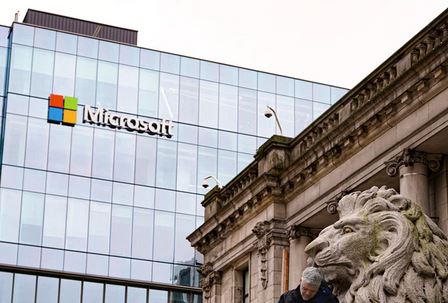Microsoft Stock Sinks On AI Spending?
↵

Image Source: Unsplash
It wasn’t long ago when shares of a mega tech company would sink if they weren’t doing enough investment in AI.
But now things seem to have shifted, as Microsoft (Nasdaq: MSFT) stock sank about 5% after the company reported fiscal Q1 earnings on Wednesday evening. The big reason that some of the financial press was reporting was that investors were concerned about overspending on capital expenditures, or AI.
The concern is that too much spending now could hurt short-term profitability, particularly in an environment where AI stocks could be in a bubble and the AI boom could fizzle due to uncertainty over the true ROI of AI investments.
While this may be true for many companies, it is probably not the case with Microsoft, the second largest cloud computing company behind Amazon. This is one area where AI spending is critical to meet the massive AI spending.
After the initial knee-jerk selloff, Microsoft stock started climbing back on what really was an excellent earnings report. As of 10 a.m. ET, Microsoft stock was only down about 2%. Wall Street analysts mostly recognized the strength of the results and tuned out the noise, as many of them raised Microsoft’s price target post-earnings.
It really was a good quarter for Microsoft
Overall, Microsoft turned in a strong quarter in the fiscal first quarter that ended September 30. The Magnificent 7 firm posted strong gains and easily topped analysts’ expectations.
- Revenue: $77.7B, up 17% year-over-year. This beat consensus estimates of $75.3B in revenue.
- Net income: $27.7B, up 12% year-over-year.
- Operating income: $38B, up 24% year-over-year.
- Earnings: $3.72 per share, up 13% year-over-year.
- Adjusted earnings: $4.13 per share, up 23% year-over-year. This beat estimates of $3.66 per share.
“Our planet-scale cloud and AI factory, together with Copilots across high value domains, is driving broad diffusion and real-world impact,” Satya Nadella, chairman and CEO of Microsoft, said. “It’s why we continue to increase our investments in AI across both capital and talent to meet the massive opportunity ahead.”
The big driver for Microsoft was its cloud business, specifically its Azure cloud computing segment.
Overall, Microsoft Cloud generated $49.1 billion in revenue, up 26% year-over-year. In addition, the remaining performance obligation (RPO), or work under contract in the pipeline, increased 51% to $392 billion.
Within the overall cloud business, Intelligent Cloud, which is its AI cloud computing business, saw revenue increase by 28%. Azure, which is its major AI cloud computing platform, saw revenue climb 40% in the quarter.
Part of that pipeline is filled by OpenAI, which just signed a new contract with Microsoft to acquire $250 billion in Azure cloud computing services.
The concerns over AI spending stemmed from a record $34.9 billion in capital expenditures last quarter, which was higher than expected.
CFO Amy Hood said it was to meet growing demand, and it will be even higher this fiscal year than it was last fiscal year.
With accelerating demand and a growing RPO balance, we’re increasing our spend on GPUs and CPUs. Therefore, total spend will increase sequentially, and we now expect the FY26 growth rate to be higher than FY25,” Hood said.
Investors should tune out the short-term noise, as AI spending by one of the leading cloud computing companies with booming growth should not be a long-term concern. In fact, it is just the opposite.
More By This Author:
One Of The Best AI Stocks Just Got Better After Blowout EarningsAI Bubble? Ark Invest’s Cathie Wood Weighs In
Qualcomm Makes Big Move To Challenge Nvidia Data Center Dominance



